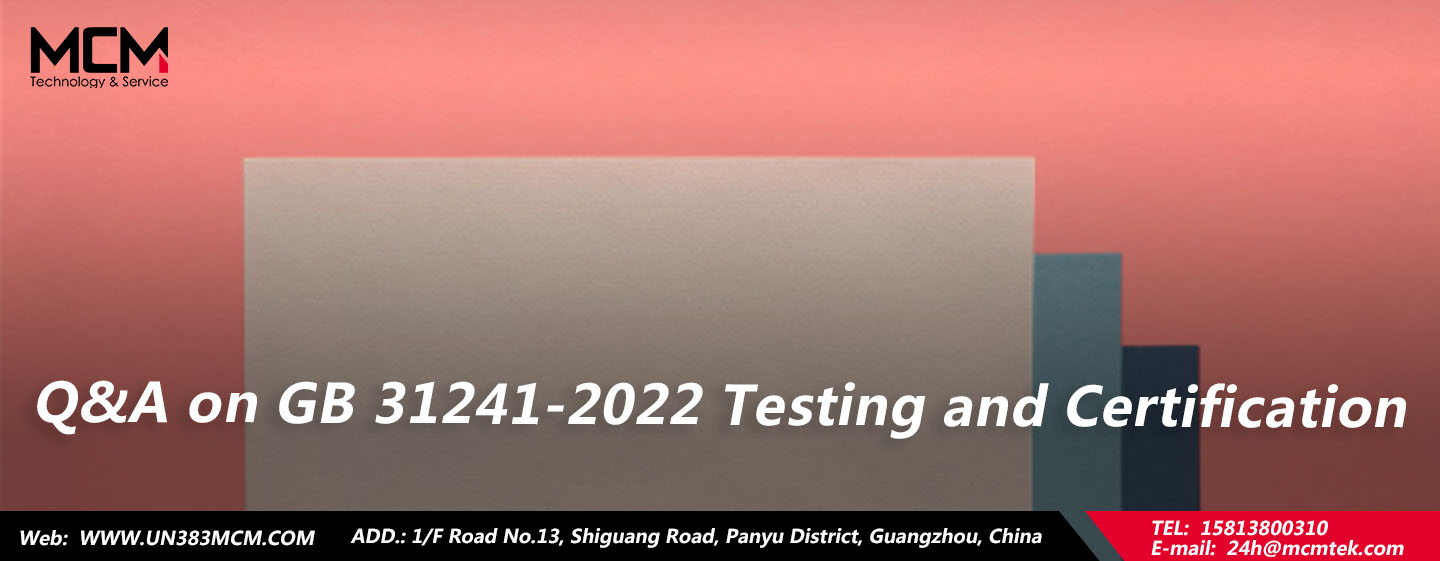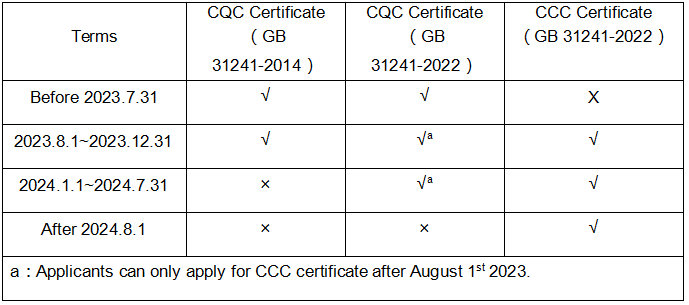As GB 31241-2022 issued, The CCC certification could start applying since August 1st 2023. There’s a one-year transition, which means from August 1st 2024, all the lithium-ion batteries cannot enter into Chinese market without a CCC certificate. Some manufacturers are preparing for GB 31241-2022 testing and certification. As there are many changes not only on testing details, but also requirements on labels and application documents, MCM has got a lot of relative inquiry. We pick up some important Q&A for your reference.
Labels
The change on label requirement is one of the most focused issues. Compared to 2014 version, the new one added that battery labels should be marked with rated energy, rated voltage, manufacturing factory and production date (or lot number).
Q: Why we need to mark rated energy? How should we mark the figure? Can we round the energy figure?
A: The main reason of marking energy is because of UN 38.3, in which the rated energy will be considered for transport safety. Normally energy is calculated by rated voltage * rated capacity. You may mark as real situation, or round the number up. But it’s not allowed to round down the number. It is because in the regulation on transport, the products are categorized into different dangerous level by energy, like 20Wh and 100Wh. If the energy figure is rounded down, it may cause danger.
E.g. Rated voltage: 3.7V, rated capacity 4500mAh. The rated energy equals 3.7V * 4.5Ah = 16.65Wh.
The rated energy is allowed to label as 16.65Wh, 16.7Wh or 17Wh.
Q: Why we need to add production date? How should we label it?
A: Adding production date is for traceability when products get into market. As lithium-ion batteries are mandatory for CCC certification, there will be market surveillance for these products. Once there are unqualified products, they need to be recalled. The production date can help to trace the lots involved. If manufacturer do not mark production date, or mark blurrily, there will be risk that all your products will be required to recall.
There is no specified template for the date. You may mark in year/month/date, or year/month, or even just mark the lot code. But in the spec there should be an explanation about the lot code, and that code shall contain information of production date. Please be noted if you mark with lot code, then there should not be repetition in 10 years.
Q: Can we mark in QR code or barcode for all information? Can we mark in English or traditional Chinese?
A: It is not allowed. QR code and barcode cannot be read by ordinary people, thus the information of battery cannot be accessed. The label should be marked in simple Chinese. If products will be sold out of China, then it’s allowed to mark in bi-language.
Q: How should we mark on small battery like coin batteries? Can they be exempted?
A: The new standard clarify that exemption of marking through agreement is not allowed. For batteries like coin batteries and earphone batteries, which are smaller than 4 cm2, the label mark can be simplified. However, information of rated energy, manufacturing plant, production date, type model, poles are still required to be marked. Others can be supplemented in package label or spec.
E.g: LP-E12
1000mAh
22/08
MCM
Safety Working Parameter
Q: Are all parameters listed in “Safety Working Parameter Table” required to be shown in spec? Can we ignore some of parameters?
A: All the parameters listed in safety working parameters table should list in spec, except for “allowed highest surface temperature”. This parameter is not considered in GB 31241, but it will be a reference in GB 4943.1 where the host is tested. Therefore we recommend manufacturers to mark this parameter. According to our experience, the allowed highest surface temperature can be 5℃ higher than battery highest working temperature.
Q: How is working range of cell and battery defined? Should we refer to only Annex A?
A: Annex A is just for reference. It’s not a mandatory requirement. But in term 5.2, there’s description as below: Battery spec should align to its internal cells’. Designation of cell and battery parameter should fully consider term 5.2 and Annex A.
Q: How should we design cell and battery parameters according to Annex A?
A: Take charging as an example. If we charge a phone or Bluetooth speaker through a charger, then the charging route should be: Charger→device→internal battery→cell. Then:
- Voltage of device≤battery limited charging voltage≤cell limited charging voltage≤Cell upper limited charging voltage
- Battery over voltage for charge protection≤Battery upper limited charging voltage ≤Cell upper limited charging voltage
Requirement on components fire resistance
Q: If there is no enclosure for a battery, how should we meet the demand of enclosure fire resistance?
A: There are two situations. One is that the battery has no enclosure, but still covered with fire-resist materials. This kind of batteries can also conduct fire resist test. If the battery neither covered by enclosure nor with other fire-resist material, then it requires the host to provide fire-resist enclosure. But the spec of host enclosure, whether it should be tested, inspected or not required, depends on the confirmation of host testing and certification.
Q: The standard also adds fire-resist requirements on other encapsulation material. Can you further explain about that?
A: This “other encapsulation material” contains the frame, package stickers, etc. The standard also exempts fire-resist requirement on some small component like tape, label and PVC pipe. For other components that are not listed in GB 31241, you may refer to the requirement on GB 4943.1.
But please be noticed that these materials are exempted for its low influence after burn, and will not cause battery fire. For other multifunctional materials, like those integrated package and label, should be well estimated whether fire-resist needed test according to its function, size and result of burn.
The term of updating new version
Q: What is MCM’s solution on GB 31241 CQC certification?
A: MCM has 2 solutions for CQC certification for new standard version.
Q: When will CQC certificate for 2014 version be invalid? When must we hold CCC certificates?
A: Below are valid terms for 2014 version CQC certificate, 2022 version CQC and 2022 version CCC certificate
Q: If we own a CQC certificate for GB 31241-2022, can we apply for CCC certificate with this?
A: Yes. The operation details will be disclosed by CQC.
Q: If batteries are only for market out of China, is CCC certificate still compulsory?
A: For products that are only for exporting from China, they are not necessarily required a CCC. But for those leftovers, they still require CCC before selling in Chinese market.
Q: After implementation of CCC certificate, should we mark CCC logo on the battery body?
A: Yes, a CCC logo is required. If the battery is too small to mark the logo, you may mark on the package label.
Tips
If you still have puzzles on above issues, or if you have any other questions on GB 31241-2022, CQC and CCC certification, you are welcomed to contact our customer service or sales. You may also write an email to service@mcmtek.com. You will always receive our warm service.
MCM has already received accreditation of CMA and CNAS GB 31241-2022, and we are CQC contracted laboratory. We can provide CQC certification for GB 31241-2022. If you have any demand, you may contact our customer service and sales.
Post time: Apr-17-2023



